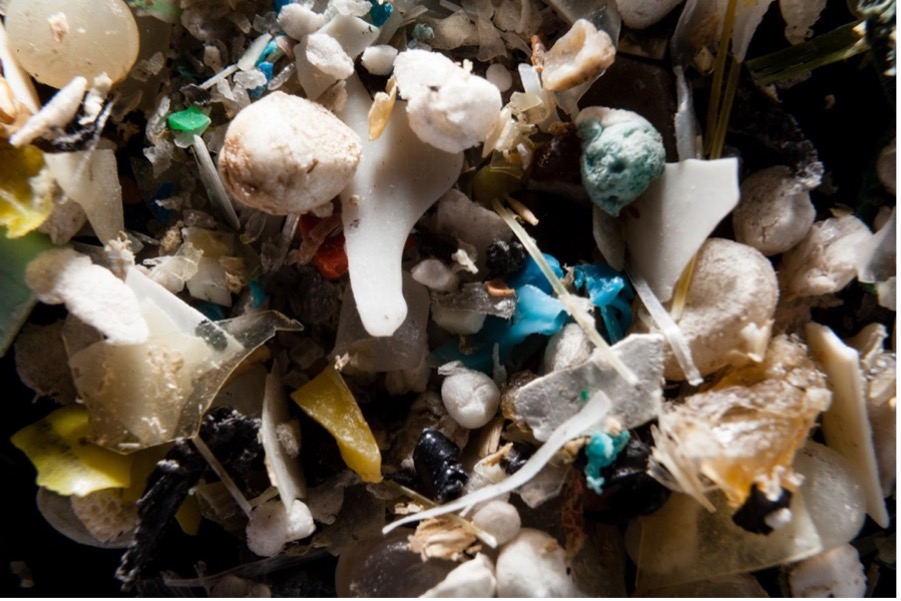Trouble in Paradise
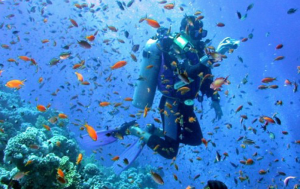
As I write on this cold, dreary New England winter day, I am reminded of my time spent scuba diving in Hawaii. On one particular instance about seven years ago, I had just finished two dives in the crystal waters off Waikiki beach where the sunken ships and marine life were punctuated only by the camera flashes from the tourist submarine that made the rounds throughout these typical Sunday mornings. Lunch and a bit of a soak in the Hawaii sunshine and I was almost ready for the final dive of the day. Unlike most Sundays where I had been through this routine, this day was a little different. I began to feel the ocean swells a little more than usual and decided to sit out the final dive. By the time everyone else was in the water, things had taken a drastic turn for the worse and without getting into the gritty details, I began to wonder what I did to so upset the gods, since even keeping water down into the lower reaches of my digestive system was a luxury I wouldn’t experience for at least the next three days.
Oyster’s Revenge
If this story strikes a chord with you, my loyal reader, then you have probably had the same, end-of-days experience that is food poisoning. As it turned out, this was a delayed effect from the raw oysters I had eaten the Friday before…I haven’t had one since. There are several ways that shellfish can cause food poisoning in humans. In all cases, this is because oysters (and other bivalves such as mussels, clams, and scallops) are filter feeders. This means they eat by filtering the tiny plankton from the water around them, including bacteria, photosynthetic algae, and the viruses that accompany them (Fig. 2). Each one of these constituents (viruses, bacteria, and algae) accumulates inside the bivalves and while the majority are not harmful, there are some bacteria and viruses that are pathogenic, and some algae that secrete toxin. Once the concentration of either the bacteria, virus, or algal toxin is high enough, the oyster may become poisonous to larger animals (fish, aquatic mammals, and yes, humans) when consumed.
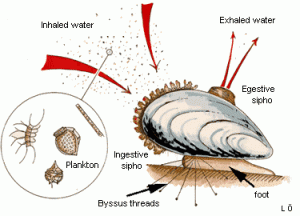
In the specific case of the algae, some genera of diatoms (Pseudo-nitzschia) produce a toxin called domoic acid (DA) which causes a very specific type of shellfish poisoning called amnesic shellfish poisoning. It gets its name because in addition to the normal body response to food poisoning, the compound can also interfere with brain chemistry and cause short-term memory loss. On August 18, 1961, there was a report of chaotic seabirds in California that were believed to be under the influence of DA, and this incidence supposedly influenced Alfred Hitchcock’s The Birds! However, DA doesn’t just affect the surface waters and the animals that live there. Diatoms (and other marine algae) are a large constituent of marine snow (MS) which is the collective term for tiny particles that fall all the way to the deepest, darkest parts of the ocean (Fig. 3). MS gets its name because by the time these particles reach the sea floor, they have the appearance of falling snowflakes. MS can be a very important food source for the animals that live in the briny deep and away from the more life-giving, sunlit waters because in addition to the photosynthetic algae, it consists of a variety of organic matter that includes dead or dying animals, fecal pellets, sand, and bacteria. If that algae includes the diatoms that make DA, this can mean the accumulation and transport of DA to deep ocean waters where it may be consumed by, and potentially poison, the animals that live there. To find out if this is the case, a group of researchers from North and South Carolina and California, led by Dr. Astrid Schnetzer conducted a series of laboratory experiments.
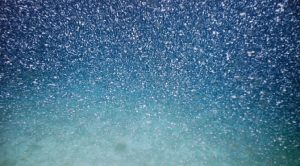
The Science
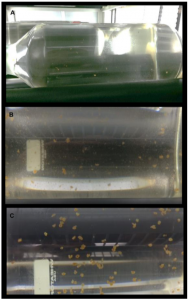
The deep ocean has an average depth of about 4000 meters (2.5 miles), and sinking algae can take between 1.5 to 3 months to reach these depths. The specific rate depends on how quickly the individual cells begin to aggregate as marine snow, and how large the individual marine “snowflakes” become since a larger particle will sink faster. To mimic the growth of the algae, and subsequent sinking of the individual cells and aggregates, Dr. Schnetzer and her team used roller bottles filled with the DA-producing algae and their favorite food (Fig. 4). As these bottles roll, the algae are perpetually suspended in the water and continue to fall and aggregate into larger, marine snow particles. Think of this like a water treadmill for algae. They kept the bottles rolling for a total of 10 weeks with the first 3.5 weeks simulated to act like the warm, sunlit waters for growth, followed by colder, dark conditions that the particles would experience as they sank deeper into the water. During the entire time, the scientists sampled the bottles to check for cell density (number of algal cells per volume of water), the amount of DA that was being produced, and some of the other nutrients associated with algae growth.
Results and Implications
The scientists first observed that they were able replicate conditions that lead to rapid algae growth (algae bloom) and the subsequent DA concentrations were similar to those experienced during a major “toxic event” along the California coast. Why this species of algae produces the toxin in excess during these events is not precisely known, but it is caused by stress to the organism, likely attributed to low levels of required nutrients encountered during a bloom, or possibly the existence of bacteria that begin to colonize the MS aggregates. Once the simulated bloom was complete and the particles began to sink, Dr. Schnetzer and her team found that DA concentrations continued to be significant throughout the experiment. Many organisms feed on MS aggregates both while the particles are sinking, and once they reach the bottom, and as the DA-laden particles are digested, they accumulate in the bodies of the tiny organisms that feed on them, and then make their way up the food chain. This means that just like the filter-feeding shellfish, once the DA reaches high enough concentrations, many animals can become toxic and affect larger animals (like humans). Their study shows that even in areas where a toxic algal bloom has not been observed, the shellfish and other marine animals may be affected due to the continuous transport of DA to the ocean depths. Studies show that bottom-dwelling (benthic) fish and shellfish have concentrations of DA that routinely exceed the regulatory limit for consumption by humans. As the market for commercially-available, benthic fish and shellfish grows, proper procedures and testing are essential to reduce the number of instances of food poisoning, and ruining a perfect Hawaii day.
I am completing my doctorate at the Graduate School of Oceanography at the University of Rhode Island where I study the community structure and evolution of deep-sea sediment bacteria. I have also been an adjunct professor at the Community College of Rhode Island for two years. I earned a B.S. in Aerospace Engineering from the University of Miami and spent 12 years in the US Navy driving submarines before coming back to grad school.


